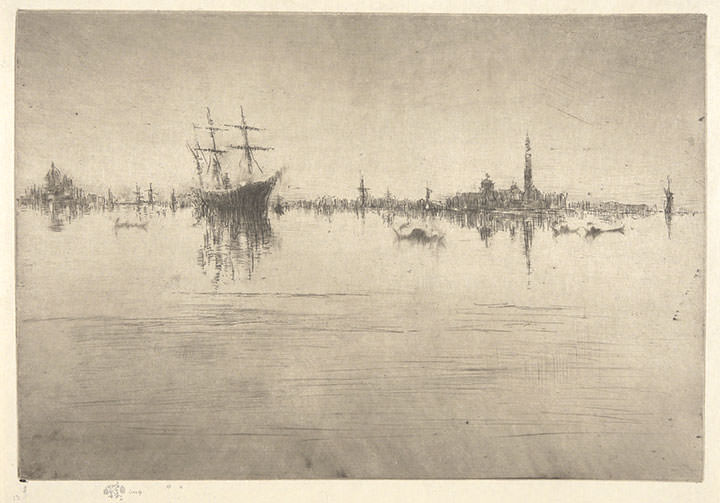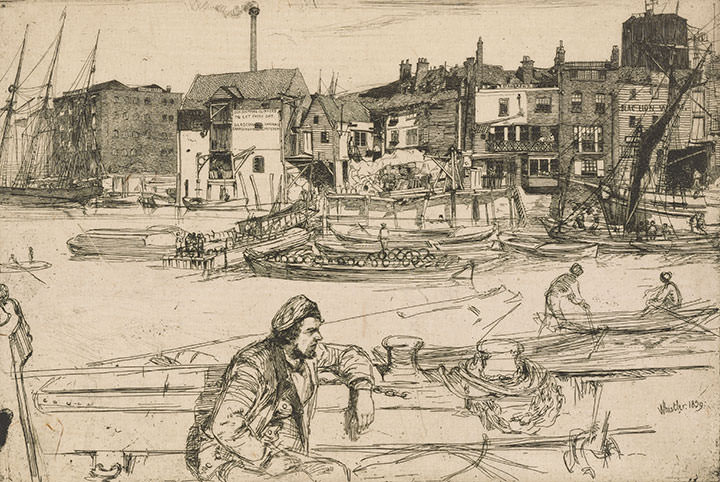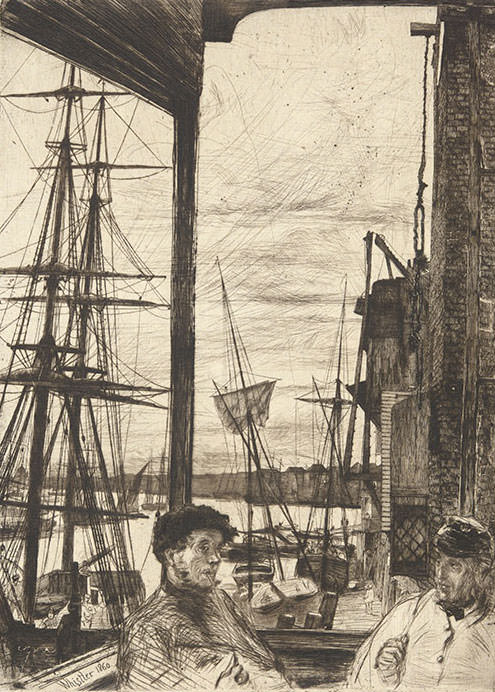January 30–July 19, 2015
First exhibition at the Gallery dedicated to
James Abbott McNeill Whistler (1834–1903) focuses on the artist’s exquisite and
masterful etchings
Whistler in Paris, London, and Venice
examines the life and artistic development of James Abbott McNeill Whistler
(1834–1903), one of the most celebrated artists of the 19th century, through
the lens of three of his earliest and most innovative sets of etchings, the
so-called French, Thames, and Venice
Sets. The sets are representative of three important periods in
Whistler’s life: as a student in Paris, absorbing the lessons of his Realist
contemporaries and the Old Masters; as an emerging artist in London, forging a
name for himself as an etcher; and as a well-known artist and teacher in
Venice, trying to recover his reputation and fortune following a devastating
bankruptcy. Over 100 objects from the Yale University Art Gallery’s permanent
holdings, including etchings of Venice by Mortimer Menpes, one of Whistler’s
most devoted pupils, and several lively works by Whistler’s contemporaries
Édouard Manet, Francis Seymour Haden, Childe Hassam, and Joseph Pennell, are
joined by more than a dozen works from the collection of the Yale Center for
British Art, providing further perspective on Whistler’s life
and influence.
Exhibition Overview
Born in Lowell, Massachusetts, in 1834, raised in Saint
Petersburg, Russia, and educated for three years at the United States Military
Academy at West Point, Whistler had a nomadic and cultured upbringing. During
these formative years, he realized that he wanted to be an artist and began
training in drawing, first at the Imperial Academy of Fine Arts in Russia and
later at West Point. He then studied etching at the U.S.
Coast Survey in Washington, D.C., before dedicating himself full time to art at
age twenty-one and leaving for Paris in 1855. Though he never returned to the
country of his birth, Whistler always identified as an American and reveled in
his status as an outsider, in both nationality and artistic output.
As Whistler matured as an artist, he began to cast himself
as the “mercurial butterfly”—his signature soon resembled a stylized version of
the insect—and to create what he dubbed “art for art’s sake.” The works on view
showcase this artistic evolution and represent three major periods in
Whistler’s life. The first part of the exhibition focuses on his Parisian stay
and the influences and artists he encountered there. Among the works is a
selection of etchings from the series Twelve Etchings after Nature
(1857–58; published 1858), better known as the French
Set, Whistler’s first published series and the first art that he
aggressively marketed. These etchings reveal his commitment to working directly
from nature and his close study of works by Diego Velázquez, Rembrandt van
Rijn, and Johannes Vermeer. In Paris, Whistler befriended artists associated
with the Realist and Impressionist movements, including Edgar Degas, Henri
Fantin-Latour, and Édouard Manet. Works by some of Whistler’s associates are
also on view in the exhibition.
In 1859 Whistler moved to London, where he forged a name for
himself as an etcher and celebrity of the art world. The foundation of the
second part of the exhibition is a complete set of A Series
of Sixteen Etchings of Scenes on the Thames and Other Subjects
(1859–71; published 1871), commonly called the Thames
Set, which established Whistler’s reputation as an etcher par
excellence. Its imagery consists almost exclusively of the changing urban
waterscapes of the unsavory commercial districts along the Thames River, where
Whistler lived and worked during his earliest years in London.
Whistler’s etching sojourn in late 1879 to Venice, where he
tried to recover his reputation and fortune following a devastating bankruptcy,
is the focus of the third section of the exhibition, which features selections
from the First Venice Set and Second Venice Set
(1879–80; published 1880 and 1886, respectively). In some of these
extraordinary prints, Whistler captured the landscape dematerializing behind
shrouds of soft mist tinged by fading twilight, as he had done earlier in a
series of oil paintings known as the Nocturnes, one of
several abstract terms Whistler adopted to refer to the mood of a painting
rather than its subject. While in Venice, he befriended a small group of
expatriate artists, whose work is featured alongside Whistler’s in this section
of the exhibition.
The French, Thames, and Venice
Sets are important milestones in the Etching Revival, which
flourished in Britain and abroad during the Victorian era and absorbed Whistler
and members of his circle. The final section of the exhibition explores the
influence of Whistler’s etchings on his students and contemporaries—including
Childe Hassam, John Marin, Mortimer Menpes, and Joseph Pennell—who carried on
the etching tradition and delighted in the expressive potential of
the medium.
Also on view are two of Whistler’s original copper plates,
as well as other materials that illuminate the artist’s mastery of etching and
of printing processes and techniques. Whistler often reworked his exquisitely
etched plates, varied his application of the inks, and alternated paper types,
making every impression a unique work of art.
“It is splendid that the Gallery’s first exhibition of
Whistler’s art will not only focus on his three superlative series of etchings,
made in Paris, London, and Venice—some from our own collection and others
generously lent by the Yale Center for British Art—but will also greatly
sharpen and deepen our understanding of the artist by illuminating the very
different circumstances under which he made each of these famous sets,” states
Suzanne Boorsch, the Robert L. Solley Curator of Prints and Drawings.
Heather Nolin, curator of the exhibition, expands on this:
“Most audiences, when they think of Whistler, likely bring to mind the large
painted portrait of his beloved mother, Anna. Yet, it was Whistler’s etchings
that first made him famous, and they remain central to understanding his genius
and enduring legacy,” states Nolin. “Whistler had a keen aesthetic sense, and
found beauty in the unlikeliest of places, such as the seedy docklands along
the Thames River. Even places already renowned for their beauty, such as the
city of Venice, were transformed by Whistler into more breathtakingly sublime
versions of themselves. His genius combined natural artistic abilities and an
eye for form and composition with technical virtuosity in etching and printing.”
James Abbott McNeill Whistler, Nocturne, from the First Venice
Set , 1879–80. Etching and drypoint on wove paper, 8 7/8 x 12 1/2 in.
(22.5 x 31.8 cm). Yale University Art Gallery, Gift of Leonard C. Hanna, Jr.,
Class of 1913
James Abbott McNeill Whistler, Black Lion Wharf , from the Thames Set , 1859. Etching on Asian paper, 8 1/8 x 11 3/8 in. (20.6 x 28.9 cm). Yale University Art Gallery, Gift of J. Watson Webb, b.a. 1907, and Electra Havemeyer Webb
James Abbott McNeill Whistler, The Piazzetta , from the First Venice Set , 1879–80. Etching and drypoint on laid paper, 10 1/16 x 7 1/16 in. (25.5 x 18 cm). Yale University Art Gallery, Everett V. Meeks, b.a. 1901, Fund
James Abbott McNeill Whistler, La marchande de moutarde (The Mustard Seller), from the French Set , 1858. Etching on chine collé, 17 x 12 in. (43.2 x 30.5 cm). Yale University Art Gallery, The Walter R. Cal - lender, b.a. 1894, Memorial Collection, Gift of Ivy Lee Callender
James Abbott McNeill Whistler, Thames Police (Wapping Wharf), from the Thames Set , 1859 (printed 1864). Etching on laid paper, 16 x 10 3/4 in. (40.6 x 27.3 cm). Yale University Art Gallery, Gift of J. Watson Webb b.a. 1907 and Electra Havemeyer Webb
James Abbott McNeill Whistler, The Unsafe Tenement from the French Set , 1858. Etching on laid paper recycled from an antique book, 8 x 10 1/2 in. (20.3 x 26.7 cm). Yale University Art Gallery, Gift of Robert W. Carle, b.a. 1897





